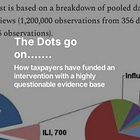And on and on
How can decision-makers justify promoting the mammoth undertaking of annual influenza vaccination when the best-quality evidence base is near empty?
This was the first question we left you with in the previous post.
In 2008, we examined several policy documents written by influential organisations from WHO, the UK, the US, Germany, Australia and Canada. The power brokers of influenza prevention created compelling policy arguments for vaccination. For example, the WHO estimated that “vaccination of the elderly reduced the risk of serious complications or death by 70-85%”. What they didn’t point out was that this estimate was based on single studies. In the US, reductions in cases, admissions, and mortality of grandma were central arguments for extending vaccination to healthy children aged 6-23 months.
Therefore, we asked simple questions like who wrote the policy documents, whether there was a methods chapter explaining how the bigwigs reached their conclusions, and whether they had done some quality assessment of the studies or the data.
We were persistent and looked inside some of these documents. All policy documents contained mi…
Keep reading with a 7-day free trial
Subscribe to Trust the Evidence to keep reading this post and get 7 days of free access to the full post archives.



